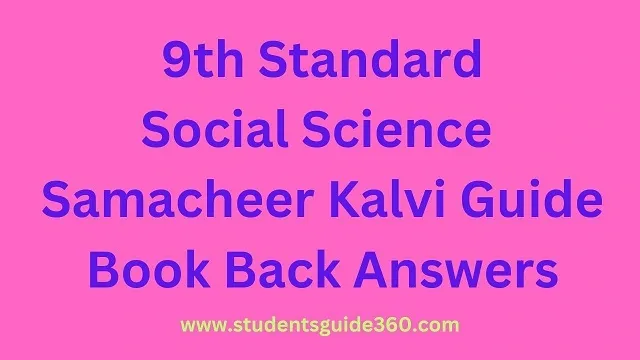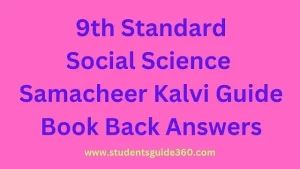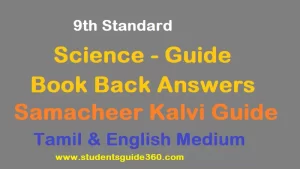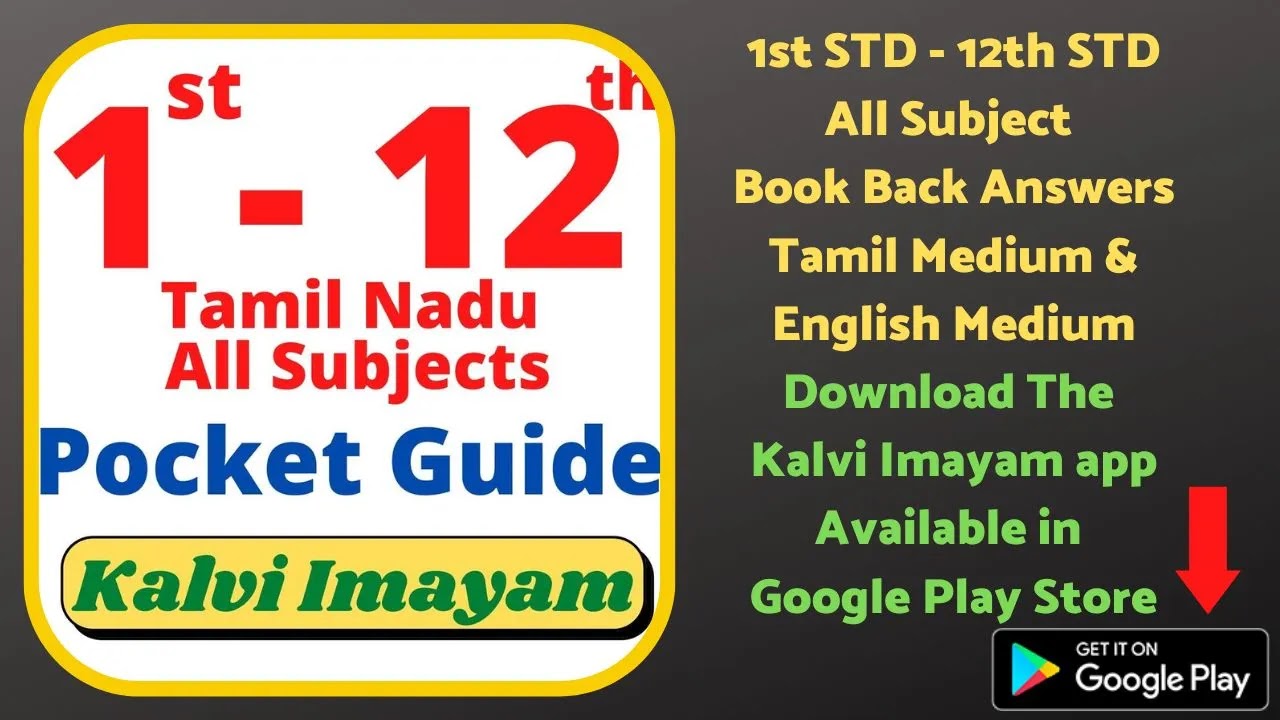9th Social Science (History) Lesson 3 Book Back Answers
9th Standard Social Science Book Back Answers History Lesson 3 Early Tamil Society and Culture Book Back Answers English Medium. Class 9 All Subject Book Answers. TN Class 9 Social Science All Unit Book in Answers TM & EM.

9th Social Science (History) Lesson 3 Early Tamil Society and Culture – Book Back Answers
I. Choose the correct answer:-
1. The name of the script used in the Sangam Age ……………
- English
- Devanagari
- Tamil – Brahmi
- Granta
Ans: Tamil – Brahmi
2. The Sri Lankan chronicle composed in the Pali language mentioning about merchants and horse traders from Tamil Nadu ……………
- Deepa vamsa
- Arthasastra
- Mahavamsa
- Indica
Ans : Mahavamsa
3. The notable Chola king credited with bringing forest lands under the plough and developing irrigational facilities ……………
- Karikalan
- Rajarajan – I
- Kulothungan
- Rajendran – I
Ans : Karikalan
4. Inscription that mentions the Cheras ……………
- Pugalur
- Girnar
- Pulimankombai
- Madurai
Ans: Pugalur
5. The famous Venetian traveler who described Kayal as a great and noble city ……………
- Vasco d agama
- Alberuni
- Marco Polo
- Megasthenes
Ans: Marco Polo
6. i) Coins as a medium of exchange were introduced for the first time in the Sangam Age.
ii) Prakrit was the language used by the common people in Northern India during the Mauryan period.
iii) Vienna Papyrus, a Roman document mentions trade related to Muziri.
iv) The concept of Thinai is presented in the Tamil grammar work of Pathupattu.
- (i) is correct
- (ii) is correct
- (i) and (iii) is correct
- (iii) and (iv) is correct
Ans: (i) and (iii) is correct
7. i) Pathitrupathu speaks about the Pandya kings and their territory.
ii) The Akanaanuru describes the trading activities at Kaveri poompattinam.
iii) The Chola Emblem was the tiger and they issued square copper coins with images of a tiger.
iv) Neythal is a sandy desert region.
- (i) is correct
- (ii) and (iii) is correct
- (iii) is correct
- (iv) is correct
Ans : (iii) is correct
II. Fill in the blanks:-
1. ………….. are documents scripted on stones, copper plates, coins and rings.
Ans : Inscriptions
2. ………….. refers to systematically digging a site to recover material evidence for exploring societies of the past.
Ans : Archaeological excavation
3. ………….. is the classic work on economy and statecraft authorized by Kautilya during the Mauryan period.
Ans : Arthasastra
4. ………….. is a poetic theme which means a class or category and refers to a habitant or eco-zone with specific physiographical characteristics.
Ans : Thinai
5. ………….. referred to the Westerners including the Greeks, Romans and West Asian people.
Ans : Yavanar
III. Find out the correct statement:-
1. a) Evidence of iron smelting has been found in Kodumanal and Guttur.
b) Periplus of Erythren Sea mentions about the pepper trade with India.
c) Punch marked coins are the earliest coins used in India mostly made of gold.
d) The Sangam Age has its roots in the Bronze Age.
Ans : a) is the correct statement
2. a) The Cheras ruled over Kaveri delta and their capital was Uraiyur.
b) The Maangulam Tamil-Brahmi inscriptions mention the King Karikalan.
c) The terms Vanika and Nigama appear in Tamil-Brahmi inscriptions were different types of merchants.
d) Salt merchants were called Vanika and they travelled in bullock carts along with their family.
Ans : c) is the correct statement
IV. Match the following:-
1. Epigraphy – A. a narrative text presenting the important historical events
2. Chronicle – B.a Sangam Age port
3. Pastoralism – C.an ornament made in precious stone.
4. Cameo – D.the study of inscriptions
5. Arikkamedu –E. nomadic people earning livelihood by rearing cattle.
Ans: 1- D, 2 – A, 3 – E, 4 – C, 5 – B
V. Answer the following questions briefly:-
1. Archaeological sites provide evidence of past history – Discuss.
- Archaeology is the scientific study of all the remains of the past that are discovered through digging or excavations conducted at various historical sites.
- Archaeological sites provide ample evidences to know the history of past.
- Archaeological sources include monuments, coins ornaments, shells of pottery, sculpture, weapons, tools, bones, vessels, etc, used by people in the past.
2. How important are coins as a source of evidence for the study of Sangam Age?
- Coins as a medium of exchange were introduced for the first time in the Sangam Age.
- The coins of Cheras, Cholas and Pandyas and Romans were important source of evidence.
- The coins give information on the social and economic conditions of Sangam period.
- They also tell us the extent of the kingdom, its relation with neighboring and foreign kingdoms.
- Roman coins discovered in Coimbatore region, Karur and Madurai shows that our ancestors traded with the people of Rome.
3. The Tamil rulers were independent of Mauryan authority. What explanation would you offer.
- The Tamil rulers were independent of Mauryan authority because Ashokan inscriptions found in present day Odisha, Karnataka, Telangana and Andhra Pradesh are not seen in Tamil Nadu and Kerala.
- So we can conclude the status of Tamil rulers.
4. Agriculture was one of the main sources of subsistence in Sangam Age. Give reasons.
- The economy of Sangam Age was mixed as elaborated in the Thinai concept. Agriculture was one of the main occupations of the people.
- The people also involved in other occupations like fishing, pottery making, jewellery making iron manufacturing, trade, etc. But, agriculture was the main source of subsistence in Sangam Age.
- Both wet and dry land farming were practiced. In the river valleys and tank-irrigated areas, paddy was cultivated.
- People in the forest adopted Punam of shifting cultivation.
5. Overseas interactions brought glory to ancient Tamilagam. Give examples in support.
- Tamilagam had connections with countries overseas both in the east and west.
- Roman ships used monsoon winds to cross the Western Sea or the Arabian Sea to connect Tamilagam.
- Spices including pepper, ivory and precious stones were exported from Tamilagam.
- Metal including gold, silver and copper were imported for other countries.
- Roman coins discovered in Coimbatore region, Karur and Madurai shows the existence of brisk traded with Rome
VI. Answer all the questions given under each caption:-
1. Hero Stones:
a) What was the common practice in a pastoral society?
Raiding cattle owned by adjoining tribes and clans was common practice in a pastoral society.
b) Who plundered the cattle wealth of enemies?
Tibal chieftains.
c) How were the dead warriors remembered?
The dead warriors were remembered as Martyrs.
d) Which Tamil text describes the procedures for effecting here stones?
Tholkappiyam.
2. Non-Tamil sources (Foreign Accounts):
a) What does the presence of the non-Tamil sources reveal?
Non-Tamil literary sources offer information on early Tamil society.
b) Name the classic work of the Mauryan period that makes a mention that the pearl and shells came from Pandya country.
Arthasastra.
c) What is a chronicle?
It is a narrative text presenting the important historical events in chronological order.
d) Who speaks about the pepper trade between Roman Empire and India?
Pliny speaks about the pepper trade between Roman Empire and India.
3. Industries and Crafts of the Sangam Age:
a) What were the important aspects of urbanization?
Emergence of cities, development of industries, economic life of the people, literature, Systematic administration, etc are the important aspects of urbanization.
b) What is the Tamil name for a potter?
Kalamceyko.
c) What were the different types of pottery used by the people?
Black ware, russet coated painted ware, black and red ware were types of pottery.
d) Identify the Iron implements required for agriculture and warfare.
Swords, daggers and spears were required for agriculture and warfare.
VII. Answer the following in detail:-
1. To what extent do you think the political powers of Tamilagam influenced Sangam age polity?
Among the political powers of the Sangam Age, the Cheras, the Cholas and the Pandyas occupied pre-eminent positions. They were known as Muvendhar.
The Cheras:
- The Cheras ruled Kerala and the Western part of Tamil Nadu.
- Vanchi was the capital of the Cheras while Musiri and Thondi were their port towns.
- Pathiruppathu speaks about the Chera kings and their conquests.
The Cholas:
- The Cholas ruled over the Kaveri delta and Northern parts of Tamil Nadu.
- Their capital was Uraiyur and their port town was Kaveripoompattinam.
- Karikalan is notable among the Chola Kings.
- The administration of the Cholas reached its zenith in the later Chola period.
- During this period, literature, art and architecture flourished.
The Pandyas:
- The Pandyas ruled the southern part of Tamil Nadu.
- Madurai was their capital. They were the patrons of Tamil scholars.
- They patronized Tamil Sangams in which Tamil poets and poetess assembled and composed poems and literary texts.
Velirs:
- Apart from the Vendars, there were Velirs who occupied territories on the margins of the muvendhar.
- The velirs were seven in number. They were Pari, Kari, Ori, Nalli, Pegan, Ai and Athiyaman.
- These chieftains had alliance with one or other of the muvendhar and helped them in their battles against the other Vendhars.
2. Indicate how the industries and crafts of the Sangam Age contribute to their economy.
- In the Sangam Age, there were professional groups that produced various commodities. The system of production of commodities is called industry. Apart of agriculture, they also practiced Iron manufacturing, Jewellery making, textile production, etc.
Iron Industry:
- Iron manufacturing was an important artisanal activity. Iron smelting was undertaken in traditional furnaces. Iron implements were required for agriculture and warfare.
Jewellery making:
- Sangam Age people adorned themselves with a variety of ornaments. The rich people wore jewels made of gold, precious stones and copper. They wore ornaments made of clay, terracotta, iron and glass beads. Gold coins from Rome were used to make jewellery.
Textile production:
- Textile production was another important occupation. Tamil literatures refer to cloth ‘Kalingam’ and other fine varieties of textiles. Periplus mention the fine variety of textiles produced in the Tamil region.
Trade:
- Foreign traders especially the Greeks, Romans and West Asians popularly known as Yavanars had a brisk trade with Tamil people. The Roman coins excavated at Coimbatore, Madurai and Karur proves it.
- From the above, we can understand that the industries and crafts of the Sangam Age contributed to the economy of Tamil people.



